
Tobacco-hornworm pupa
What’s that critter?
Many homeowners call the Extension service to hopefully get a vexing critter ID via phone with only a description. If it rings a distinct bell, such as “it’s flat little gray bag-like cocoons stuck all over my patio walls” then it’s a slam dunk for the Master Gardeners and Extension staff and the client can be provided with information they can follow up on their own. Usually we have to encourage the clients to send samples and allow a complete diagnostic investigation so that the critter ID is as accurate as possible. Even if they are in a hurry, it is better to take the time to arrive at an accurate answer rather than a quick answer which could be wrong, especially if control measures are sought. Primary considerations for diagnosis are:
- Sample type, either physical or photo
- Was this a single critter, or are there more?
- Where was it found?
- When was it found?
- What was it doing (if alive)? Especially biting or chewing.
- Were there any new introductions recently to the area?
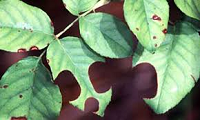
Leaf-cutting bee damage
Critter samples would best be entire, alive and brought into the Extension office the same day it was collected, either in a closed container or zip-lock baggie. Droppings, or frasse can also be included in a separate container. Deceased critters can be frozen or preserved in alcohol. Alternatives would be clear pictures showing relative size (such as next to a coin or pen) either printed out or e-mailed. It may even be possible to ID the critter by only the damage done to plants, lawns or homes, in which case the same sample types would be needed.
Where the critter was found can be crucial. If inside the home, was it near a water or food source as in a bathroom or pantry? Or was in found on windowsills or near a particular piece of furniture?
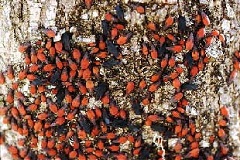
Jadera bugs, nymphs & adults
When the critters are seen, time of day, during or after weather events or a particular season of the year, can also give important clues. Millipedes often invade homes underneath door sills after heavy rains. Jadera bugs seem to show up by the hundreds in the fall when Golden Rain trees’ seeds (their favorite food source) ripen.
What the critter is doing can also help lead to an effective ID especially if found chewing on a particular plant.
Were there any new plants or furniture introduced to the yard or home? Snails can be hidden in container plants, or wood destroying insects in second-hand furniture.
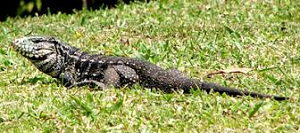
Sometimes a picture taken from a distance is best! Tegu lizard – invasive & aggressive
Hopefully a good sample is all that is needed for a critter ID. The diagnostic interview may still be conducted to ensure there aren’t any anomalies that may rule out a first choice. Extension staff are not trying to frustrate homeowners, but give the most accurate information and effective control if warranted.
So what were those “flat little gray bags” stuck all over the patio? Quite probably the ubiquitous larval form of the Plaster Bagworm, Phereoeca uterella now known as the Household Casebearer. Either name can be used as a search term for the homeowner to look up and confirm a Critter ID diagnosis done over the phone.
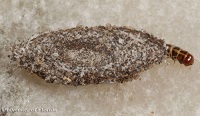
Household casebearer, AKA: Plaster bagworm
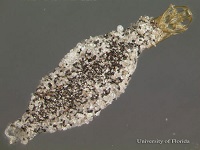
Magnified view of a Household casebearer’s remains
For more information, contact your local County Extension Master Gardeners.
 0
0
